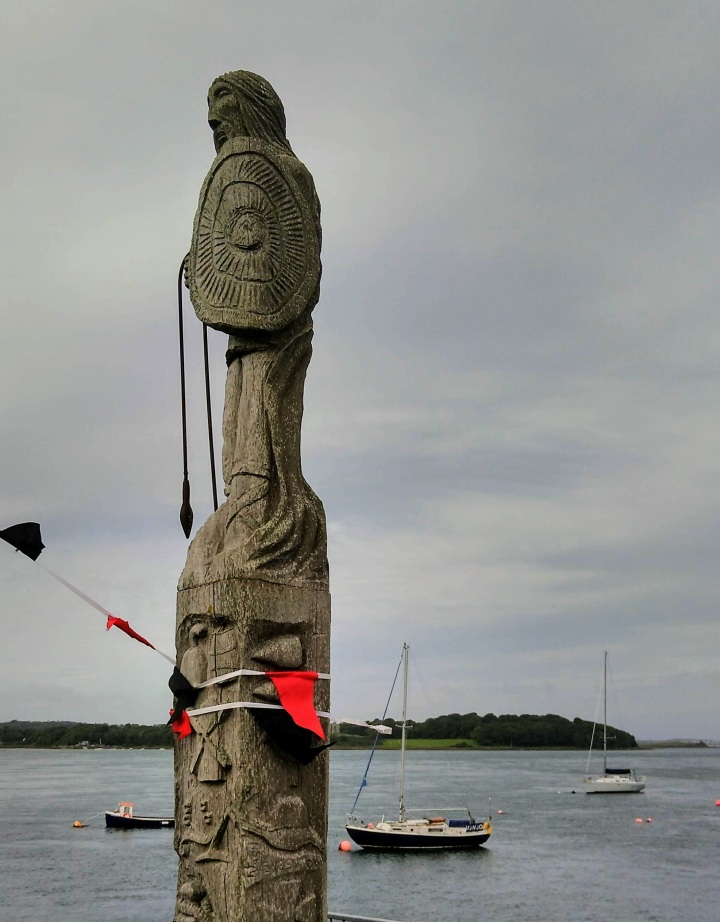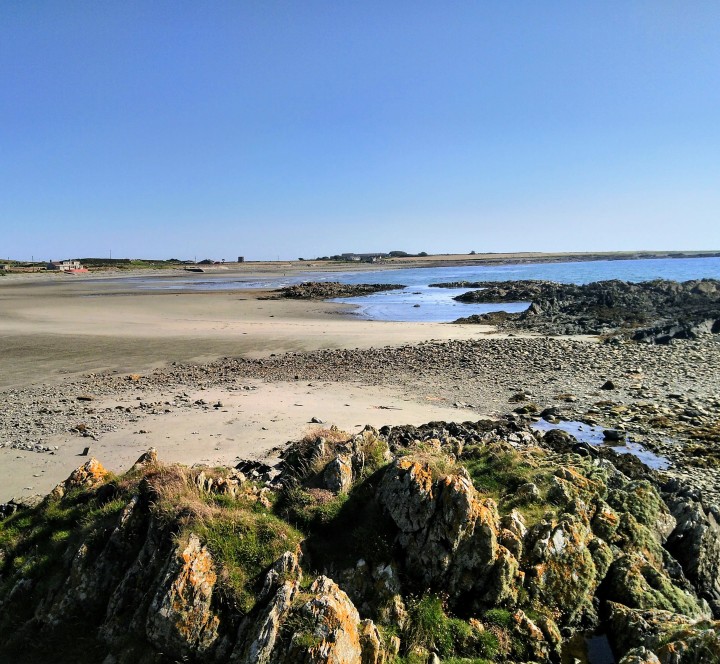Nestling at the foot of the Ards Peninsula, in the heart of the Strangford and Lecale Area of Outstanding Natural Beauty, Portaferry is a town in which to pause and soothe your soul. It may officially be on GMT, but “Portaferry Time” seeps into your psyche. Stay for the day, preferably a week, or maybe even a lifetime and discover this magical place for yourself.
Throughout my many years of living in Northern Ireland, I have passed through Portaferry with my eyes closed. Not literally you understand, but on a circular scenic drive around the tranquil shores of Strangford Lough, via the ferry, or on a family day out to the only aquarium in the province. So, having returned to my homeland after 8 years living away, it has been a revelation and joy to discover the delights of this tiny Irish town.

Portaferry’s most obvious attraction is its location, perched amidst the gentle slopes of fertile drumlins, yet right by the treacherous entrance to Strangford Lough. This is the largest sea lough in the British Isles, with over 100, mostly uninhabited, islands. As one of only three Marine Nature Reserves in the whole of the UK, it is home to 2000 species of marine wildlife.

Whether you travel from near or far, this peaceful place has so much to offer – heritage, natural and built, is in abundance as well as activities including golf, sailing, fishing, water-sports, walking, cycling, boat trips and diving. Galleries and workshops showcase arts and crafts from talented local artisans. Gourmet chefs tempt you with tasty produce from their doorstep – you certainly won’t go hungry.
This whole area is steeped in Christian heritage, thanks to St Patrick’s arrival through The Narrows of the Lough in the fifth century. Just a couple of centuries later, St Cooey founded the Holy Wells to the south of Portaferry. In the medieval and early modern period, Strangford Lough was known in Irish as Loch Cuan, meaning “sea-inlet of bays/havens”. One of the area’s most ancient sites, Templecranny Graveyard, which has graves dating from the 17th century, once had a medieval church.

By the ninth century, the Vikings had arrived and named the area Strangr Fjörðr, meaning “strong sea-inlet”, as the currents here are amongst the fastest in the world (up to 8 knots). As I watched the ferry from Strangford cross the currents almost sideways, the tide propelled a yacht through its waters at what was definitely “a rate of knots”! At the Quay stands a statue, “The Watcher”, representing the Viking influence on the area. Local ship design was often based on that of their longboats.
As I followed the town’s Heritage Trail, I learnt that the earliest recorded ferry ran from 1155. Historians of The Portaferry and Strangford Trust have discovered that boatbuilding was a thriving business by the 17th century, encouraged by the Savage family – William Le Savage landed in Ulster in the latter half of the 12th century during the conquest of Ulster by Sir John de Courcy. He built Portaferry Castle (one of many tower houses in the region) and the windmill, built in 1771 and one of over 50 on the Ards Peninsula. As I paused for breath at this viewpoint above the town, I revelled in the spectacular views of the Mourne Mountains, Slieve Croob, the Isle of Man and even Scotland.
This shipbuilding, of over 30 vessels between 1812 & 1822 alone, made the town a thriving commercial hub and the lough’s leading port. Incredibly, larger vessels of up to 400 tons, carrying passengers and cargo to cities as far away as Canada, were also built here. Export of local goods led to the development of many businesses in the town including a bleach works with a green for the linen market, ropeworks, a tanning yard, tobacco factory, distillery, brewery, drying kiln, sawmill and watermill grinding wheat and oats. Many of the houses were home to sea merchants and other residents with maritime connections.
Imports of sugar, rum, whiskey, cloth and coal built commercial trade in the area along with exports of corn, herring, cattle, potatoes and kelp. As was common in remote coastal places, smuggling was also rife. Along the Shore Road may be found the fishermen’s cottages, some still housing fishermen to this day, with shellfish still landed here. In the 1800s the site of the fish market became an Orange Lodge, used by the whole community as a snooker club and dance hall. Today, this outstanding red brick building is home to the Credit Union.
Just above the Credit Union, in the centre of the town, is the Market Square, dominated by the newly-restored Market House. This was originally built in 1752, but had to be partially rebuilt following its defence against the United Irishmen’s uprising in 1798, when it saw service as the garrison for the yeomanry of the town, with cannon placed at either end.
As I walked down Windmill Hill, I was intrigued by the sight of an imposing neo-classical building standing out proudly amongst the surrounding vernacular housing. Portaferry hosted one of Ireland’s first Presbyterian congregations in Ireland, who built what is now named Portico in 1841, basing its design on the ruined Temple of Nemesis in Greece. Today this congregational home also houses a heritage and arts centre and is a popular venue for live entertainment.
Lovers of The Arts may be interested in artistic legends celebrated in Portaferry. Alexander Bell Filson Young (1876–1938) grew up in Ferry Street. Initially a journalist, who published the first book about the sinking of the RMS Titanic only 37 days after the sinking, Filson Young was also an essayist, war correspondent in the Boer War and World War I, a programmes advisor to the BBC and the author of two novels. Aside from his literary work, he was an organist and composer, and a pioneer of motoring and aviation. Another famous son of the town was Joseph Tomelty – born 1911 on Shore Road – a celebrated character actor and playwright. He worked in film, television, radio and on the stage.

Having explored the ancient streets of this intriguing town, I soon set out to enjoy the surrounding scenic landscape. Kearney Village & coastal path lie just 3miles east of Portaferry and were the first purchase in Northern Ireland for the National Trust. Here they reconstructed the first recorded dwellings of the 18th century, based on maps of the 1834 Ordnance Survey.

Having stretched my legs southwards along the coastal path, I reached the empty sands of the beach at Knockinelder. Such a treat after living with mudflats for years! Moving a few miles south-east of Portaferry, Barr Hall/BallyQuintin Farm lies to the southernmost tip of the Ards Penninsula.
Another windy walk took me to the lookout post viewpoint for more fabulous views of the Isle of Man and Mournes. This nature lovers’ idyll is known to hold such rarities as Irish Hares, yellowhammers, otters and seabirds including whimbrel and gannets. Rare plants sea kale and yellow-horned poppy may also be found here and perhaps even the Common Blue butterfly.
Venturing northwards along the Shore Road, Nugent’s Wood, now a firm favourite with my little dog, offers views across the Narrows to Strangford and, in season carpets of bluebells, with the hope of a glimpse of a red squirrel or harbour porpoises in the waters. For a closer look at the wonderful sea life found in Strangford Lough, visit the Exploris aquarium which first opened in 1987. Unusually this takes its water from the lough, the minerals of which benefit the animals of the aquarium & seal sanctuary within.
Moving right up to date and popular culture, in my time away Northern Ireland has become a hotspot for film locations. The immensely popular series Game of Thrones has spawned a whole industry, including tours and destinations around the whole of Northern Ireland for its fans, yet Portaferry is perhaps one of the less flaunted.
Quintin Bay was the nearest location used and so Fiddler’s Green, a pub and B&B in the town’s centre, became the home of one of the ten GoT doors. These intricately carved doors, depicting moments inspired by the sixth season of the show, were carved from trees blown down in Storm Gertrude at the Dark Hedges.
I hope you will forgive my longer than usual rambling but, as you may tell, I have been thrilled to find so much of interest around this tiny place. What has surprised me most has been the warmth of the people. Sadly so many towns have now lost the pleasure of a chat with the local butcher or bakery assistant. Here car drivers wave a friendly acknowledgement in passing and hold ups do not attract a single blasted horn or blaspheme. Calmness instils calm and friendliness makes friends. I look forward to my time here and encourage you to discover it for yourselves.





















Thank you for such a beautiful tour Hilary. I have visited the Mournes but not Portaferry. I shall have to remedy this…🌼
LikeLiked by 1 person
And thank you for taking the time to read it and comment! Very much appreciated 🙂
LikeLiked by 1 person
We are occasional “blow ins” to Portaferry and feel great affection for this little place. It takes a day or two to adjust to ‘Portaferry time’, but adjust we do. Maybe unwind is a better word than adjust…whatever – the result is living in the moment, seeing properly instead of glancing, having long and fascinating conversations with townspeople, and generally making time for the things which nourish the soul. Everyone should experience the Portaferry effect !
LikeLiked by 1 person
Beautifully put Hazel. It is good for our souls indeed to make time for these things 🙂
LikeLike
Thank you for taking the time to put this all together. Portaferry is one of my favourite places. It’s always does me good to spend a day drifting around this beautiful place
LikeLiked by 1 person
And thank YOU Roberta. Good of you to encourage me 😉
LikeLike
Super write up. Although I was born in Portaferry and moved to Carnmoney when I was 4, I still visit regularly just to take in the magnificent scenery and events. Still have some kinfolk there.
Thanks, Frank
LikeLiked by 1 person
Thanks Frank – nice to know the wee place has its fans 🙂
LikeLike
In three weeks we are coming to the UK and included in that is our first trip to Ireland. We hope to visit Portaferry during our week in your lovely country
LikeLike
Welcome/Failte Julie, hope you have a really fab trip and enjoy some downtime in this lovely area. 🙂 H
LikeLike